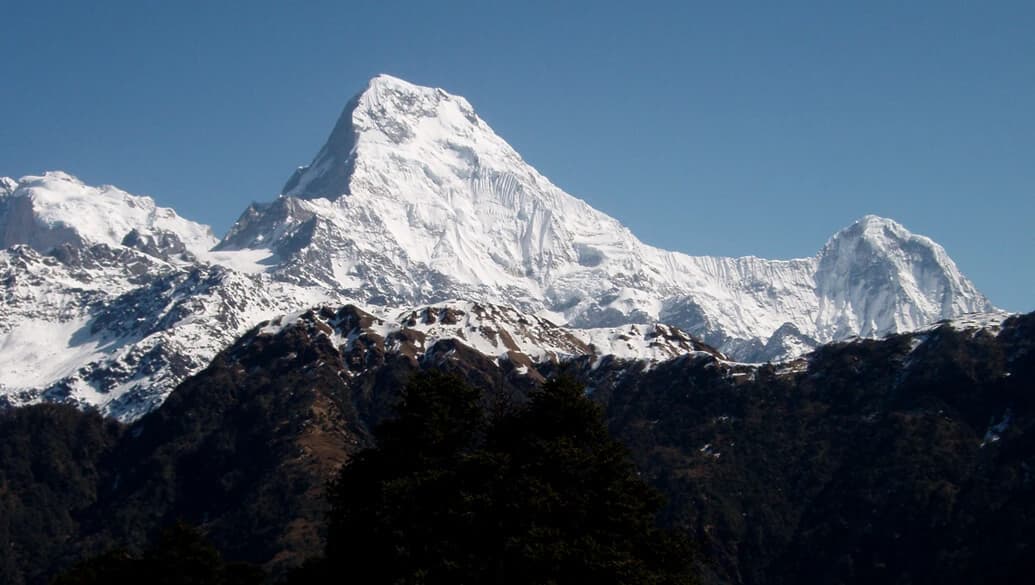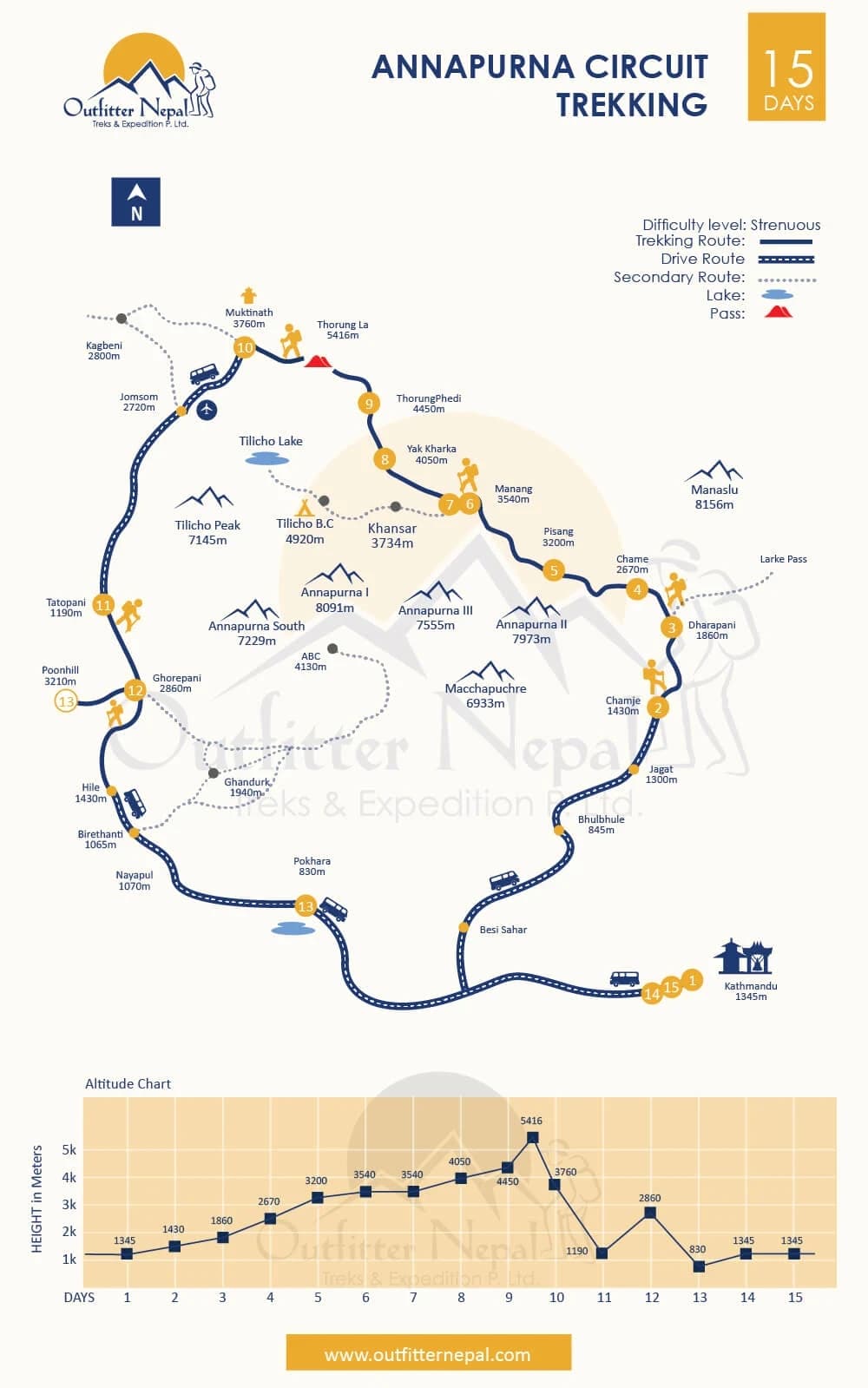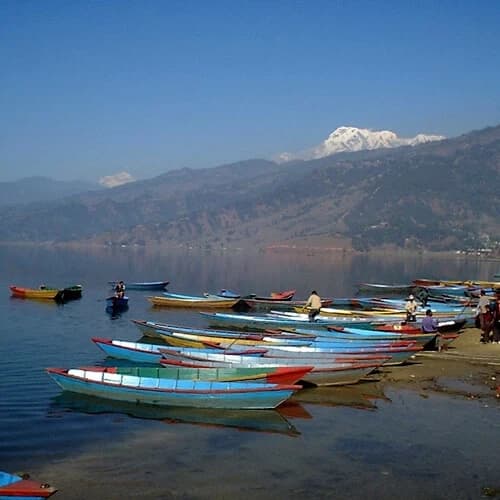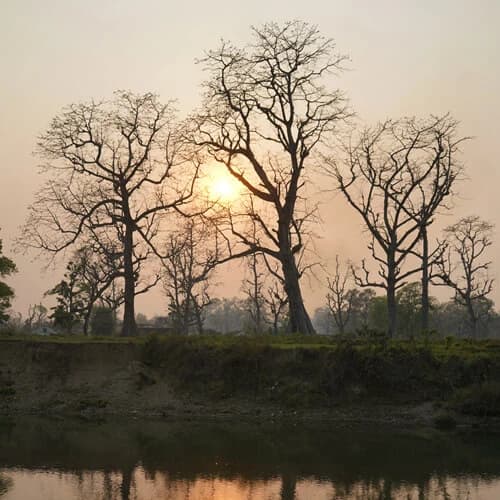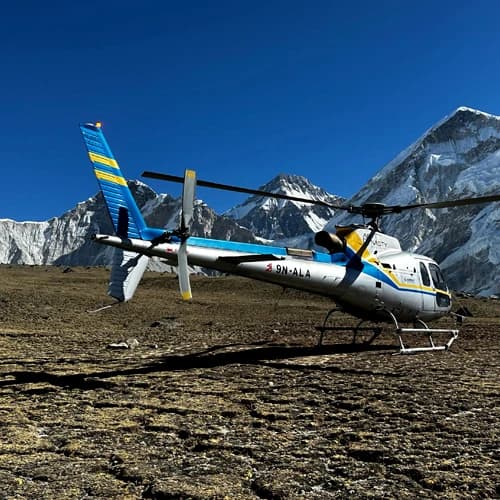15 Days Annapurna Circuit Trek Highlights
- Unwind yourself with a relaxing and scenic drive from Kathmandu to Pokhara.
- Have a relaxing walk and enjoy the evening walks at the lakeside.
- Relish the majestic backdrop of the Himalayas as you explore the tourist hub of Pokhara.
- Walk through beautiful traditional villages, including Ghorepani, Chame, and Dharapani.
- Cultural immersion and interaction with the locals.
- Spectate mesmerizing views of the Annapurna range, Dhaulagiri, and Manaslu.
- Crossing Thorong-La pass (5415m), the trek's highest and most challenging section.
- Visit Muktinath Temple, one of the most religiously and spiritually revered holy sites.
- Explore the Kali Gandaki Gorge, the deepest canyons in the world.
- Relax in the therapeutic hot springs at Tatopani.
Annapurna Circuit Trek 15 Days Overview
The Annapurna Circuit Trek 15 Days is one of the most popular trekking routes in the world. It is a challenging expedition in the Nepalese Himalayas. The spectacular journey to the Annapurna region offers a mixed experience of natural wonders and cultural immersion.
During this trekking, you will cover approximately 220 km and witness breathtaking landscapes and mountain ranges. The Himalayan panorama in this expedition is mainly dominated by Mount Annapurna (8,091m), the 10th highest peak in the world.
Since its opening in mid-1980, the Annapurna Circuit Trekking 15 Days has inspired many travel enthusiasts worldwide. In terms of adventure and experiencing a thrilling hike in the mountains, it is compared to the Everest Base Camp Trekking.
The trekking is a perfect blend of natural and cultural elements. It takes you to awe-inspiring destinations like Muktinath, Marshyangdi River Valley, and high mountain passes. With every step, you discover a new wonder of this captivating area. You will traverse varied landscapes, from the cultivated plains and multicolored rhododendron forests to the alpine regions.
This 15 days Annapurna circuit hike is an unforgettable experience that will leave a long-lasting impression on those participating. The warm hospitality of the locals and the serene beauty of Annapurna will create beautiful memories to cherish forever.
Link Words: Jomsom Muktinath, Upper Mustang, Nar-Phu Valley, Manaslu, and Tsum Valley.
15-Day Annapurna Circuit Trek Best Time
The Annapurna Circuit Trek 15 Days can be trekked all year round, but spring and autumn offer the best conditions. These seasons fall in February, March, April, and May and September, October, November, and December, respectively. We advise booking your trekking during these times to ensure a safe and enjoyable travel experience.
Spring begins after the monsoon season and is Nepal's peak trekking and travel season. Traveling during this season offers clear skies and good weather. The temperature is constant, ranging from 5 degrees to 20 degrees Celsius during the day. Similarly, the chances of snowfall and rain are slim, making it good weather for traveling outdoors.
Autumn is the only season when it comes to nature and festive mood. It is characterized by stunning scenery, blue skies, and inspiring mountain landscapes. The temperature is between 4 and 22 degrees Celsius, and the night is much colder. This allows tourists to walk without facing heat or cold during the day. The weather is fabulous most of the day, and a whiff of cold air indicates winter.
Note: Though the best times to trekking the Annapurna Circuit are spring and autumn, it can also be done in summer and early winter. You must be well-prepared under our direction and expert supervision to make it through. We shall be pleased to arrange a proper package schedule for the Annapurna areas according to your choice and availability.
15 Days Annapurna Circuit Trekking Route
The remarkable journey begins in Besisahar, a quiet town in the Lamjung district of Nepal. In the coming days, you will spend time in rural areas throughout the trekking. Tourists will go to small villages in remote areas and camp overnight at Indigenous teahouses. Sleeping in their simple residences and communicating with the locals is an observation of the resident's daily lifestyle. As one goes deeper into the valley along the hike, the terrain will change into alpine landscapes with icy glaciers and steep peaks encircling the area.
Moving on, you will ascend to Thorong La Pass (5,416m), the highest section of the trekking. The landmarks provide breathtaking scenery of the surrounding mountains, such as the Annapurna range. The trail proceeds to Muktinath, a religious site revered by Hindu and Buddhist followers. You will visit the area through religious processes like offering prayers and meditating in the serene serenity. The exhilarating trip finishes when you arrive at Jomsom, where you make the final descent back to Pokhara.
Note: Although our regular itinerary for the 15 Days Annapurna Circuit trekking Nepal, it can be customized according to your preference. You can deduct or include additional days or destinations to suit your travel preferences and needs.
15 Days Annapurna Circuit Trek Cost for 2026, 2027
The 15 Days Annapurna Circuit Trekking Cost USD 1195 per person, and the package, depending on your group size, ranges from USD 1075 to USD 1015 per pax. Other factors influencing the trekking cost include the season you are traveling in, the package chosen, the services included, and the itinerary. The more days you spend on the route, the more you spend on food, accommodation, and services.
Note: If you would like to learn and discuss more about the 15-Day Annapurna Circuit Trekking Cost, feel free to email or WhatsApp us.
